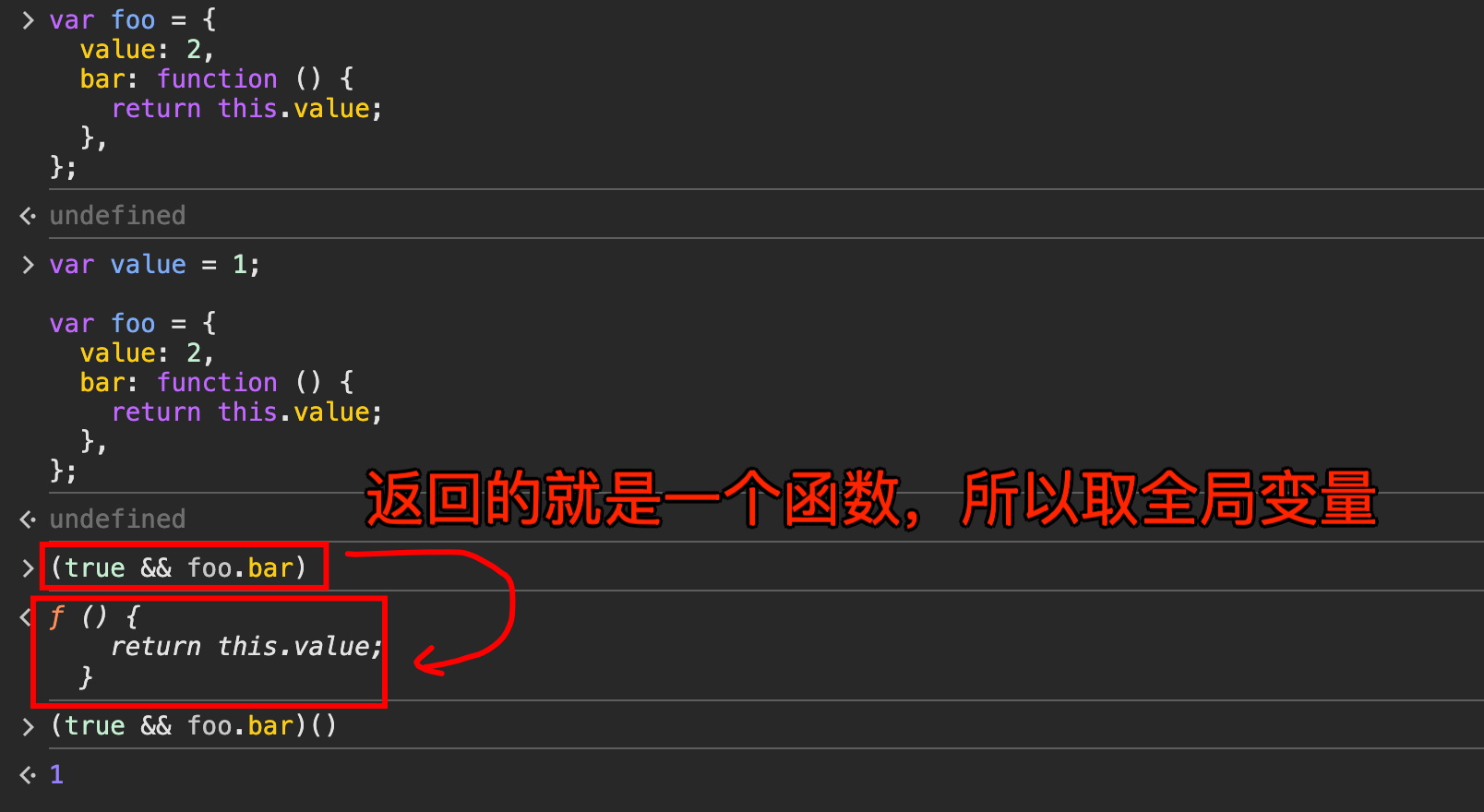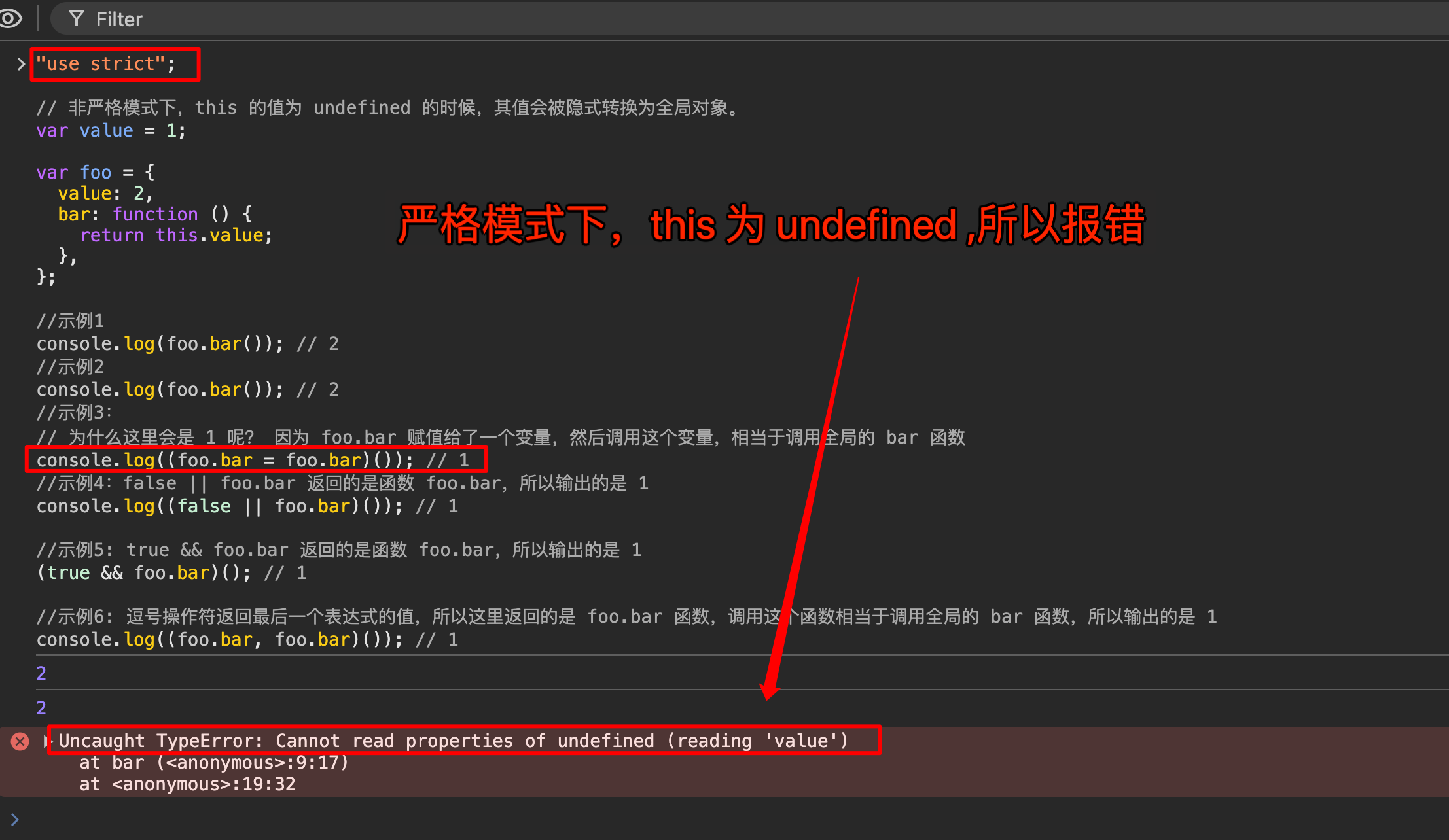this 指向问题汇总
目录
1. this 指向问题
总结:
- 箭头函数的
this是词法作用域的 this,在定义时就确定了 - 普通函数的
this是动态的,取决于调用方式 - 如果需要方法中的
this指向对象本身,应该:- 使用普通函数定义方法
- 或在对象方法内部定义箭头函数
- 或在类的构造函数中定义箭头函数
const obj = {
fn1: () => {
// this 指向定义时所在的对象,即 window
// 如果 new 调用,则报错
console.log(this);
},
fn2: function () {
console.log("fn2", this);
},
fn2: function () {
// 这里的箭头函数继承了 fn2 的 this
const arrowFn = () => {
console.log(this);
// 这里的 this 会指向 obj
};
arrowFn();
},
};
obj.fn1(); // Window {...}
// 因为还是在 obj.fn 下面调用
obj.fn2(); // { fn1: [Function: fn1], fn2: [Function: fn2] }
fn2 = obj.fn2;
// 这就是在 window 上面调用
fn2(); // Window {}
const x = new obj.fn1(); // Uncaught TypeError: obj.fn1 is not a constructor
const y = new obj.fn2(); // fn2 {}
2. this 的问题
- 第 5 行是在普通方法里面
var name = 123;
var obj = {
name: 456,
print: function () {
// 这里的 this 指向 obj,作为对象的方法被调用
console.log(this.name); // 456
function a() {
console.log(this.name); // 123
}
a();
},
};
// 普通函数的 this 指向取决于在何处被调用,这里 a 函数是在全局作用域被调用的,所以 this 指向全局对象
obj.print(); // 123
a 函数是再全局作用域被调用的,因为它在 15 行调用的
2.1. a 函数为什么打印出 123
这是因为函数 a 是作为==普通函数调用的,而不是作为对象的方法调用==。
- 函数调用的位置决定 this:
var name = 123;
var obj = {
name: 456,
print: function() {
console.log(this.name); // 456
function a() {
console.log(this.name); // 123
}
a(); // 关键在这里!这是一个普通函数调用
}
};
在这个例子中:
obj.print()是作为对象方法调用,所以print函数中的this指向obj- 但内部函数
a()是作为普通函数调用的,相当于直接调用a(),此时this指向全局对象(非严格模式下)
- 解决方案:
如果想让内部函数
a中的this也指向obj,有几种方法:
// 方法1:使用变量保存外部的 this
var obj = {
name: 456,
print: function() {
var that = this; // 保存外部 this
function a() {
console.log(that.name); // 456
}
a();
}
};
// 方法2:使用箭头函数
var obj = {
name: 456,
print: function() {
const a = () => {
console.log(this.name); // 456
}
a();
}
};
// 方法3:使用 bind
var obj = {
name: 456,
print: function() {
function a() {
console.log(this.name); // 456
}
a.bind(this)();
}
};
- 为什么会这样? JavaScript 中的 this 绑定规则如下:
// 1. 默认绑定(普通函数调用)
function foo() {
console.log(this); // window
}
foo();
// 2. 隐式绑定(作为对象方法调用)
const obj = {
foo: function() {
console.log(this); // obj
}
};
obj.foo();
// 3. 显式绑定(使用 call, apply, bind)
function foo() {
console.log(this);
}
foo.call(obj); // obj
// 4. new 绑定
function Foo() {
console.log(this); // Foo 实例
}
new Foo();
- this 绑定的优先级:
new 绑定 > 显式绑定 > 隐式绑定 > 默认绑定
在你的例子中:
var name = 123;
var obj = {
name: 456,
print: function() {
function a() {
// 这里是默认绑定,因为是普通函数调用
console.log(this.name); // 123
}
a(); // 普通函数调用,this 指向全局对象
}
};
这就是为什么内部函数 a 中的 this.name 会打印 123 而不是 456 的原因。
这是 JavaScript 中常见的一个“陷阱“,需要特别注意函数的调用方式来确定 this 的指向。
在实际开发中,为了避免这种问题:
- 使用箭头函数
- 使用
bind - 使用变量保存外部
this→ ==that== - 使用类的方法(类中的方法默认是严格模式)
3. this 的指向问题
3.1. 非严格模式
// 非严格模式下,this 的值为 undefined 的时候,其值会被隐式转换为全局对象。
var value = 1;
var foo = {
value: 2,
bar: function () {
return this.value;
},
};
//示例1
console.log(foo.bar()); // 2
//示例2
console.log(foo.bar()); // 2
//示例3:
// 为什么这里会是 1 呢? 因为 foo.bar 赋值给了一个变量,然后调用这个变量,相当于调用全局的 bar 函数
console.log((foo.bar = foo.bar)()); // 1
//示例4:false || foo.bar 返回的是函数 foo.bar,所以调用后,输出的是 1
console.log((false || foo.bar)()); // 1
//示例5: true && foo.bar 返回的是函数 foo.bar,所以调用后,输出的是 1
(true && foo.bar)(); // 1
//示例6: 逗号操作符返回最后一个表达式的值,所以这里返回的是 foo.bar 函数,调用这个函数相当于调用全局的 bar 函数,所以输出的是 1
console.log((foo.bar, foo.bar)()); // 1

3.2. 严格模式

4. 普通函数和箭头函数在 this 绑定上的区别
4.1. 普通函数的 this
普通函数的 this 是动态绑定的,取决于函数在哪儿调用:
// 1. 直接调用:this 指向全局对象(非严格模式)或 undefined(严格模式)
function normalFunc() {
console.log(this);
}
normalFunc(); // window 或 undefined
// 2. 作为对象方法调用:this 指向调用该方法的对象
const obj = {
name: 'object',
method: function() {
console.log(this.name);
}
};
obj.method(); // 'object'
// 3. 构造函数调用:this 指向新创建的实例
function Person(name) {
this.name = name;
}
const person = new Person('John');
console.log(person.name); // 'John'
// 4. call/apply/bind 调用:this 指向指定的对象
const context = { name: 'custom' };
normalFunc.call(context); // { name: 'custom' }
normalFunc.apply(context); // { name: 'custom' }
const boundFunc = normalFunc.bind(context);
boundFunc(); // { name: 'custom' }
4.2. 箭头函数的 this
箭头函数的 this 是定义时绑定的,继承自定义时所在的上下文:
==继承外层作用域的 this==
// 1. 继承外层作用域的 this
const obj = {
name: 'object',
normalMethod: function() {
// 箭头函数继承 normalMethod 的 this
const arrowFunc = () => {
console.log(this.name);
};
arrowFunc();
},
arrowMethod: () => {
// 这里的 this 继承全局作用域的 this
console.log(this.name);
}
};
obj.normalMethod(); // 'object'
obj.arrowMethod(); // undefined
4.2.1. 不能通过 call/apply/bind 改变 箭头函数的 this
// 2. 不能通过 call/apply/bind 改变 this
const arrowFunc = () => {
console.log(this);
};
const context = { name: 'custom' };
arrowFunc.call(context); // window
arrowFunc.apply(context); // window
const boundFunc = arrowFunc.bind(context);
boundFunc(); // window
4.3. 常见问题和解决方案
4.3.1. 定时器中的 this
// 问题:普通函数
const obj = {
name: 'object',
delayLog: function() {
setTimeout(function() {
console.log(this.name); // undefined
}, 1000);
}
};
// 解决方案 1:使用箭头函数
const obj1 = {
name: 'object',
delayLog: function() {
setTimeout(() => {
console.log(this.name); // 'object'
}, 1000);
}
};
// 解决方案 2:保存 this
const obj2 = {
name: 'object',
delayLog: function() {
const self = this;
setTimeout(function() {
console.log(self.name); // 'object'
}, 1000);
}
};
4.3.2. 事件处理中的 this
// 问题:类方法作为事件处理器
class Handler {
constructor() {
this.name = 'handler';
}
handleClick() {
console.log(this.name);
}
}
const handler = new Handler();
button.addEventListener('click', handler.handleClick); // undefined
// 解决方案 1:箭头函数
class Handler1 {
constructor() {
this.name = 'handler';
}
handleClick = () => {
console.log(this.name);
}
}
// 解决方案 2:bind
class Handler2 {
constructor() {
this.name = 'handler';
this.handleClick = this.handleClick.bind(this);
}
handleClick() {
console.log(this.name);
}
}
4.3.3. 回调函数中的 this
// 问题:回调函数中的 this 丢失
class DataFetcher {
constructor() {
this.data = [];
}
fetchData() {
fetch('api/data')
.then(function(response) {
// this 指向 undefined 或 window
this.data = response.json();
});
}
}
// 解决方案:使用箭头函数
class DataFetcher1 {
constructor() {
this.data = [];
}
fetchData() {
fetch('api/data')
.then(response => {
// this 正确指向 DataFetcher 实例
this.data = response.json();
});
}
}
4.4. 总结
- 普通函数的 this 是动态的,取决于调用方式
- 箭头函数的 this 是静态的,继承定义时的上下文
- 选择使用哪种函数取决于你是否需要动态的 this 绑定
- 在需要保持 this 上下文的场景(如回调、事件处理器)中,箭头函数很有用
- 在需要动态 this 的场景(如对象方法、原型方法)中,使用普通函数更合适
4. this 指向问题
还是一样,以为自己懂了,其实没懂啊, 三个 window
let m = {
a: function () {
console.log(this);
},
b: () => {
console.log(this);
},
};
m.a(); // 输出: m 对象
m.b(); // 输出: window 对象
e = m.a;
f = m.b;
e(); // 输出: window 对象
f(); // 输出: window 对象
下面的 Class 的区别:
class A {
a = function () {
console.log(this);
};
b = () => {
console.log(this);
};
}
let aa = new A();
aa.a();
aa.b();
上面的输出都是 A 对象实例